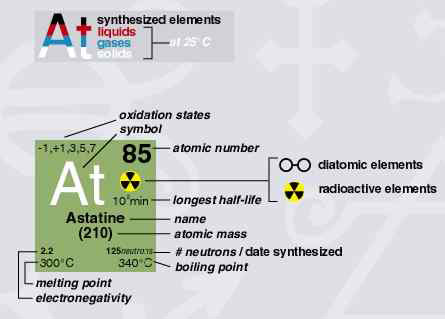
The standard information is present, along with several unique additions. (a) The isotopes of elements are described by providing the common number of neutrons (comprising 95% of existing forms), (b) the common oxidation numbers are listed to show group similarities and describe the variability of transition metal values. (c) Electronegativity values are shown in order to determine polarity in bonds. Two additional features in the same location note (d) if the element is diatomic when in a pure state - the two balls connected by a line (the line doubles for double bonding, such as oxygen) - which helps students recall that detail when completing and balancing equations. Alternatively, the location is used (e) to show if the elements are radioactive.
The poster notes (f) melting and boiling points - handy to show periodic trends and also the (g) date synthesized and (h) half-life values for the longest isotopes. These are useful data for a teacher to have readily available during a class. The items (a) (f) (g) and (h) are not included on the notebook version.